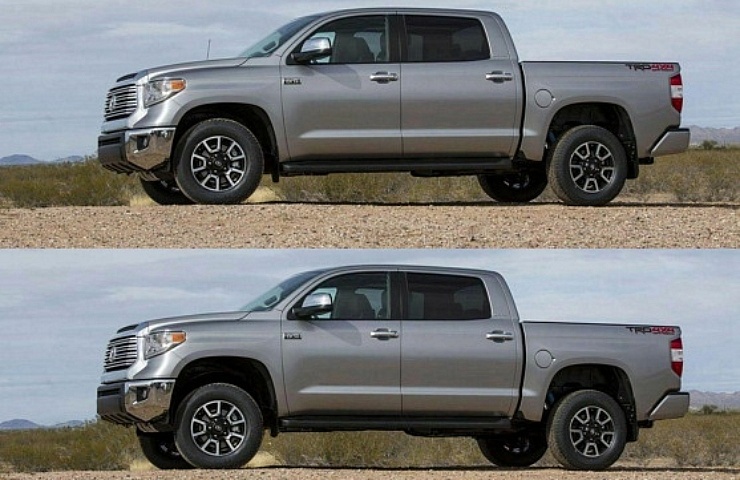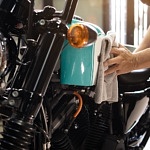Contents
Many new trucks have a slight rake or downward tilt to the front. Leveling kits are designed to bring up the vehicle’s front end and make more room for larger tires. Should you consider installing a leveling kit for your rig?
Uneven Truck Suspensions from the Factory
Why do new trucks and 4×4 vehicles leave the factory with the front end raked down? Engineers are thinking about how a truck is often used to haul stuff. When you put extra weight in the back, it raises the truck’s front end.
But truck owners these days mostly carry families and rarely haul heavy loads in the back. So, the lowered front end might start to bug you. The situation gets worse when you add extra accessories to the front of the truck, like a winch.

Metal spaces are used in most leveling kits.
Leveling Kits Are Different Than Lift Kits
A lift kit raises both the truck’s front and its rear. That increases clearance, which is helpful if you plan to hit the trails and want to clear big rocks.
In a matched lift kit, both the front and rear are raised by the same amount. As a result, you still end up with that raked, downward sloping look.
Lift kits can be expensive and require more work to install than a leveling kit. A lift kit will also dramatically change the handling of the truck.
Leveling Kit Before and After
When installing a leveling kit, the first step is to figure out how much rake your truck currently has.
- Park your truck on a level surface with its standard payload. If you usually carry a heavy toolbox, keep it on the truck.
- Go to the front wheel and measure from the center of the wheel hub to the nearest edge of the wheel well.
- Take the same measurement at the rear wheel.
- The difference is the amount of rake you have.
That distance is what the leveling kit needs to correct. If you are finicky, then measure all four wheels and average the numbers. The rake will most likely be two inches or less. If it is more than that, you might need to consider a spindle kit to raise the front end high enough.

A spindle lift could raise the front end a greater distance.
Three Types of Suspensions
Most trucks have one of three suspension designs—based on the year and model. Each style requires a specific type of leveling kit. There is not a one-size-fits-all approach.
Use filters and fitments choices on eBay Motors to determine the right application for your ride. It will be one of these three:

Have coilovers? Then this spacer will raise the front end.
Strut Extension Leveling Kits
A strut extension puts a spacer on the top or bottom of the struts, adding an extra inch or so. These work for trucks with a coilover strut, as seen on most current light-duty trucks. You don’t need to replace the struts.
Keep in mind that it’s possible to remove the spacers after adding the kits. And some kits are designed to be adjustable so you can get a precise height.

A modified torsion key is necessary for front-end suspensions.
Torsion Key Leveling Kits
If you have a torsion bar suspension, you’ll need a leveling kit for the torsion key. That’s the lever that holds the torsion bar at the preferred height.
This type of kit swaps out the factory torsion keys for a modified version. You might be tempted to adjust rather than replace the factory torsion keys.
It’s not a good idea because the existing torsion key might not raise the front high enough. Besides, that process would put more strain on the factory parts. Replacing the torsion key is the way to go.

A shock extension is necessary for some leveling kits.
Coil Spring Spacer Leveling Kits
The final custom option is to add a spacer to the coil spring. You most likely will need to squeeze in a shock extension as part of the install. This process is similar to a strut extension. But in this case, the extension is applied to the spring and not the strut.
Installing the Leveling Kit
Most leveling kits include detailed DIY directions. Kit providers might encourage the pieces to be installed by an experienced shop. But you can do it yourself if you work slow and carefully.
Read through all the directions first to ensure that you understand the work involved and the required tools. If you have an older truck, invest in a can of penetrant and spray all the nuts and bolts you’ll be removing at least a day in advance. That will make the job a lot easier.
After Installing the Leveling Kit
After the leveling kit is installed, you will probably need a wheel alignment. Let the shop know that you installed the leveling kit so they can make the necessary adjustments.
If you raised the front end to make room for a larger tire, also get your speedometer re-calibrated. This is critical because many modern trucks use readings from the speedometer for other systems—such as braking and traction control.
Cautionary Note
Changing a vehicle’s suspension will alter its handling and steering. In some cases, the leveling kit will interfere with safety sensors. And regardless, the center of gravity will be higher. If your truck has a factory warranty, the dealer might want to invalidate a truck with a leveling kit.
But it’s amazing how much an inch or two will change the vehicle’s stance. A leveling kit will lend your truck a desirable new upright look.





